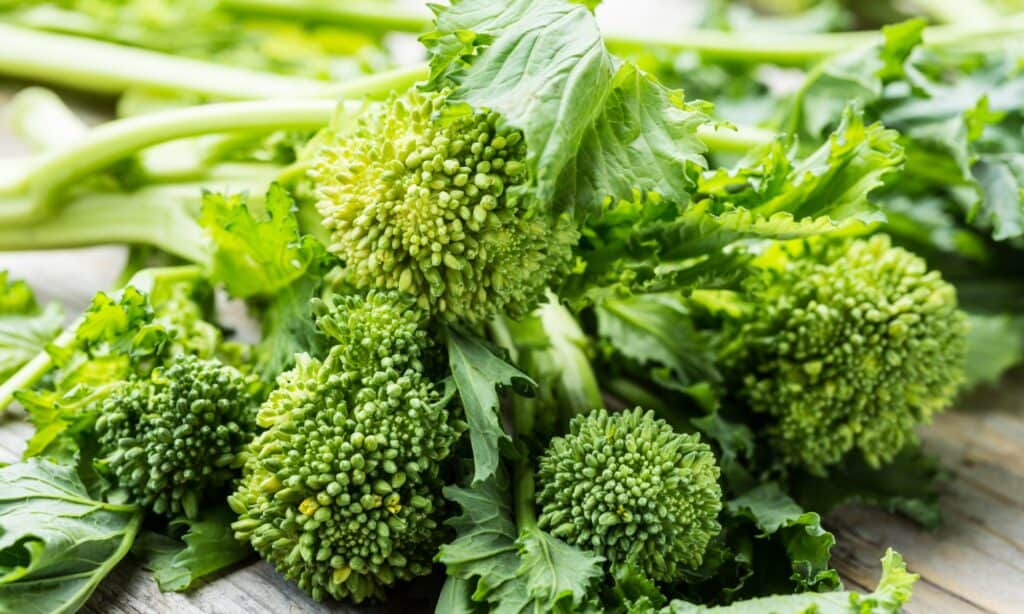Vegetables are an important part of our diet and there is a vast quantity of them out there – some better known than others. Vegetables can come in all shapes and sizes and there are some that look alike and some that share similar names even when they’re not actually the same. Therefore, it’s really important to know what is what so you can choose the best ones for you. What about broccoli rabe and rapini? Are they the same, or is there a difference between them? Let’s find out!
What is the Difference Between Broccoli Rabe and Rapini?

Broccoli rabe and rapini are different names for the same vegetable.
©iStock.com/eZeePics Studio
There is no difference between broccoli rabe and rapini – they are simply two different names for the same vegetable. However, it doesn’t even just stick to two names – its other names include broccoletti, spring rabe, Italian mustard, and Italian turnip. Broccoli rabe or rapini (Brassica rapa “ruvo”) is a vegetable in the Brassicaceae family group which is better known as the mustard or cabbage family. It is a large family group and consists of more than 4,000 species. Broccoli rabe is a vegetable that has long confused people. Despite its name, broccoli rabe is not actually broccoli and is instead more closely related to turnip. This is because they both grow from the same plant species but in different cultivated forms.
Broccoli rabe (or rapini) is native to Europe, although it is grown as a foodstuff in several other countries – including the US. It is a green vegetable that develops as spiked leaves which surround clusters of green buds – often looking like a smaller version of broccoli. Its total size is usually no more than 12 to 20 inches high and 12 to 18 inches wide. The entire plant is edible, although it is known for its bitter taste.
What are the Benefits of Rapini or Broccoli Rabe?

Broccoli rabe can improve glucose uptake.
©iStock.com/Quanthem
Rapini (or broccoli rabe) is a cruciferous vegetable that is packed full of nutrients. It is high in vitamins A and C which are important for health as they support the immune system. It contains high quantities of potassium, calcium, and iron which are imperative for maintaining bone health and for regulating blood pressure. Broccoli rabe also contains high amounts of protein and fiber.
Broccoli rabe contains antioxidants such as glucosinates which have been found to have cancer-fighting properties. They can also help to maintain (or even improve) heart health and reduce the risk of heart disease. It also contains polyphenols which can improve blood sugar levels by improving glucose uptake.
How to Cook Rapini/Broccoli Rabe
Now that you know all the reasons that you should eat broccoli rabe/rapini, you need to know how to cook it. Broccoli rabe can be used in a wide variety of recipes and eaten in many different ways – especially as all part of it is edible. However, it does have a somewhat bitter taste. The best way to lessen the bitterness is to first trim some off the stems as this is where it is the most bitter and then just boil it for a few minutes until tender. The leaves are not as bitter as the stems and are often described as being fairly nutty flavored.
After boiling, you can use broccoli rabe in virtually any way that you like. It is perfect as a side dish, in a stir-fry, or in salads. It can be added to sandwiches or pizzas, or it can even go with pasta or a meat dish. With its strong taste, broccoli rabe also goes well with garlic. Additionally, you can even use it in a pesto! So why not try this tasty, nutritious veggie?
Tips on how to Grow Broccoli Rabe/Rapini
If we’ve piqued your interest in broccoli rabe/rapini and you fancy growing some yourself, then you’ll be pleased to know that it is really easy to grow. It is a hardy cool-season vegetable that is suitable for growth in zones 3 to 10. It is best grown as an annual and can be planted either in the spring or in the fall. Broccoli rabe is a quick-growing plant and can be planted directly in the garden – there’s no need to start it indoors.
For the best results, the seeds should be planted approximately four inches apart and ¼ to ½” deep and then watered lightly. It will usually take a few days for them to begin to grow and once they begin to develop and get crowded they can be thinned out up to 12 inches apart. Broccoli rabe grows best in full sun with well-drained soil. The soil should be kept moist and watering may need to be increased during particularly warm weather.
Most varieties of broccoli rabe/rapini will reach maturity 40 to 55 days after sowing. When harvesting, leave the plants a few inches tall and with a few leaves on them and it should be possible to get up to three harvests from them in each season.
Up Next
- Broccolini vs. Broccoli Rabe: 5 Key Differences Explained
- Broccolini vs. Broccoli: What Are The Differences?
- Turnip Greens vs. Collard Greens: What’s The Difference?
The photo featured at the top of this post is © iStock.com/Quanthem
Sources
- Masterclass, Available here: https://www.masterclass.com/articles/what-is-broccoli-rabe-broccoli-rabe-vs-rapini-and-9-ways-to-cook-broccoli-rabe
- Healthline (1970) healthline.com/nutrition/broccoli-rabe-nutrition
Thank you for reading! Have some feedback for us? Contact the AZ Animals editorial team.






